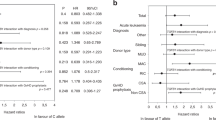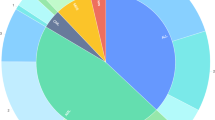Abstract
The recently described single-nucleotide polymorphism CT60, located in the 3′-untranslated region of the CTLA4 (cytotoxic T-lymphocyte antigen 4 ) gene, has been associated with susceptibility to several autoimmune diseases and has also been shown to be involved in immune responses following allogeneic stem cell transplantation (SCT). However, the contribution of the CTLA4 genotype to the control of minimal residual disease in patients with acute myeloid leukemia (AML) has yet to be explored. We investigated the association between the CTLA4 CT60 A/G genotype and the incidence of leukemic relapse in 143 adult patients with AML in first complete remission after the same chemotherapy protocol (CETLAM LAM’03). The CT60 AA genotype was associated with a higher rate of leukemic relapse (56.4 vs 35.6%, P=0.004; hazard ratio (HR)=2.64, 95% confidence interval (CI)=1.36–5.14) and lower overall survival at 3 years (39.4 vs 68.4%, P=0.004; HR=2.80, 95% CI=1.39–5.64). This is the first study to report an association between polymorphisms at CTLA-4 and AML relapse.
This is a preview of subscription content, access via your institution
Access options
Subscribe to this journal
Receive 12 print issues and online access
$259.00 per year
only $21.58 per issue
Buy this article
- Purchase on Springer Link
- Instant access to full article PDF
Prices may be subject to local taxes which are calculated during checkout



Similar content being viewed by others
References
Greenwald RJ, Freeman GJ, Sharpe AH . The B7 family revisited. Ann Rev Immunol 2005; 23: 515–548.
Chen L . Co-inhibitory molecules of the B7-CD28 family in the control of T-cell immunity. Nat Rev Immunol 2004; 4: 336–347.
Teft WA, Kirchhof MG, Madrenas J . A molecular perspective of CTLA-4 function. Ann Rev Immunol 2006; 24: 64–97.
Ueda H, Howson JM, Esposito L, Heward J, Snook H, Chamberlain G et al. Association of the T-cell regulatory gene CTLA-4 with susceptibility to autoimmune disease. Nature 2003; 423: 506–511.
Torres B, Aguilar F, Franco E, Sánchez E, Sánchez-Román J, Jiménez-Alonso J et al. Association of the CT60 marker of the CTLA-4 gene with systemic lupus erythematosus. Arthritis Rheum 2004; 50: 2211–2215.
Pérez-García A, De la Cámara R, Román-Gómez J, Jiménez-Velasco A, Encuentra M, Nieto JB et al. CTLA-4 polymorphisms and clinical outcome after allogeneic stem cell transplantation from HLA-identical sibling donors. Blood 2007; 110: 461–467.
Erfani N, Razmkhah M, Talei AR, Pezeshki AM, Doroudchi M, Monabati A et al. Cytotoxic T lymphocyte antigen-4 promoter variants in breast cancer. Cancer Genet Cytogenet 2006; 165: 114–120.
Heward J, Gordon C, Allahabadia A, Barnett AH, Franklyn JA, Gough SC . The A-G polymorphism in exon 1 of the CTLA-4 gene is not associated with systemic lupus erythematosus. Ann Rheum Dis 1999; 58: 193–195.
Hudson LL, Rocca K, Song YW, Pandey JP . CTLA-4 gene polymorphisms in systemic lupus erythematosus: a highly significant association with a determinant in the promoter region. Hum Genet 2002; 111: 452–455.
Gonzalez-Escribano MF, Rodriguez R, Valenzuela A, Garcia A, Garcia-Lozano JR, Nunez-Roldan A . CTLA-4 polymorphism in Spanish patients with rheumatoid arthritis. Tissue Antigens 1999; 53: 296–300.
Kouki T, Sawai Y, Gardine CA, Fisfalen ME, Alegre ML, DeGroot LJ . CTLA-4 gene polymorphism at position 49 in exon 1 reduces the inhibitory function of CTLA-4 and contributes to the pathogenesis of Grave's disease. J Immunol 2000; 165: 6606–6611.
Parks CG, Hudson LL, Cooper GS, Dooley MA, Treadwell EL, St Clair EW et al. CTLA-4 gene polymorphisms and systemic lupus erythematosus in a population-based study of whites and African-Americans in the southeastern United States. Lupus 2004; 13: 784–791.
Cozar JM, Romero JM, Aptsiauri N, Vazquez F, Vilchez JR, Tallada M et al. High incidence of CTLA-4 AA (CT60) polymorphism in renal cell cancer. Hum Immunol 2007; 68: 698–704.
Whiteway A, Corbett T, Anderson R, Macdonald I, Prentice HG . Expression of co-stimulatory molecules on acute myeloid leukaemia blasts may effect duration of first remission. Br J Haematol 2003; 120: 442–451.
Rezvani K, Yong AS, Mielke S, Savani BN, Musse L, Superata J et al. Leukemia-associated antigen-specific T-cell responses following combined PR1 and WT1 peptide vaccination in patients with myeloid malignancies. Blood 2008; 111: 236–242.
Huurman VA, Unger WW, Koeleman BP, Oaks MK, Chandraker AK, Terpstra OT et al. Differential inhibition of autoreactive memory- and alloreactive naive T cell responses by soluble cytotoxic T lymphocyte antigen 4 (sCTLA4), CTLA4Ig and LEA29Y. Clin Exp Immunol 2007; 150: 487–493.
O’Day SJ, Hamid O, Urba WJ . Targeting cytotoxic T-lymphocyte antigen-4 (CTLA-4): a novel strategy for the treatment of melanoma and other malignancies. Cancer 2007; 110: 2614–2627.
Acknowledgements
This study has been financed by Grant FIS PI050939 from the Fondo de Investigaciones Sanitarias, Instituto de Salud Carlos III, Ministerio de Sanidad y Consumo.
Author information
Authors and Affiliations
Consortia
Corresponding author
Additional information
The list of participant centres and current group members appears in Appendix 1.
Appendix 1
Appendix 1
The centers and investigators contributing to the CETLAM study were as follows: Institut Català d'Oncologia (ICO) Hospital Josep Trueta, Girona (David Gallardo, Ramón Guardia, Cristalina Fernández); Hospital de la Santa Creu i Sant Pau, Barcelona (Salut Brunet, Josep F Nomdédeu, Montserrat Hoyos, Anna Aventín, Jorge Sierra); Hospital Clínic, Barcelona (Jordi Esteve, Mireia Camós, María Rozman, Neus Villamor, Dolors Costa); ICO Hospital Germans Trias i Pujol, Badalona (Josep M Ribera, Isabel Granada, Albert Oriol); ICO/Duran i Reynals, L’Hospitalet de Llobregat (Joan Berlanga, Rafael Duarte, Esther Alonso); Hospital Vall d’Hebrón, Barcelona (Javier Bueno, Eva Sánchez, Teresa Vallespí); Hospital del Mar, Barcelona (Carmen Pedro, Lourdes Florensa, Francesc Soler); Clínica Teknon, Barcelona (Pilar Vivancos); Hospital Juan Canalejo, A Coruña (Pio Torres); Hospital Clínico, Málaga (M. Paz Queipo De Llano); Hospital Clínico Universitario, Valencia (Mar Tormo); Hospital Son Dureta, Palma (Joan Besalduch, Marta Barnués); Hospital Son Llatzer, Palma (Joan Bargay); Hospital Joan XXIII, Tarragona (Andreu Llorente, Lourdes Escoda); Hospital Arnau de Vilanova, Lleida (Antoni García-Guiñón); Hospital Verge de la Cinta, Tortosa (Llorenç Font); Hospital Mutua Terrassa, Terrassa (Josep M Martí-Tutusaus, Cristina Estany). The laboratory work has been carried out at the Alloreactivity Unit, Laboratori de Recerca Translacional, ICO (Arianne Pérez-García, David Gallardo).
Rights and permissions
About this article
Cite this article
Pérez-García, A., Brunet, S., Berlanga, J. et al. CTLA-4 genotype and relapse incidence in patients with acute myeloid leukemia in first complete remission after induction chemotherapy. Leukemia 23, 486–491 (2009). https://doi.org/10.1038/leu.2008.339
Received:
Revised:
Accepted:
Published:
Issue Date:
DOI: https://doi.org/10.1038/leu.2008.339
Keywords
This article is cited by
-
Development of a poor-prognostic-mutations derived immune prognostic model for acute myeloid leukemia
Scientific Reports (2021)
-
Checkpoint inhibitors in hematological malignancies
Journal of Hematology & Oncology (2017)
-
The prognostic value of cytotoxic T-lymphocyte antigen 4 in cancers: a systematic review and meta-analysis
Scientific Reports (2017)
-
A CT60G>A polymorphism in the CTLA-4 gene of the recipient may confer susceptibility to acute graft versus host disease after allogeneic hematopoietic stem cell transplantation
Immunogenetics (2015)
-
The targeting of immunosuppressive mechanisms in hematological malignancies
Leukemia (2014)



